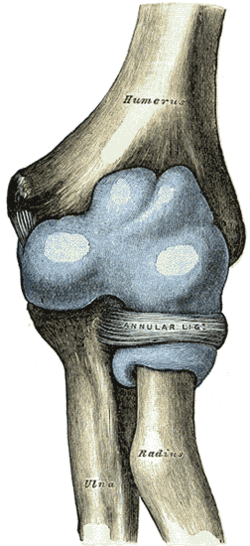| Pulled elbow | |
|---|---|
| Other names | Radial head subluxation, annular ligament displacement, [1] nursemaid's elbow, [2] babysitter's elbow, subluxatio radii |
 | |
| Capsule of elbow-joint (distended). Anterior aspect. (Nursemaid's elbow involves the head of radius slipping out from the anular ligament of radius.) | |
| Specialty | Emergency medicine |
| Symptoms | Unwilling to move the arm [2] |
| Usual onset | 1 to 4 years old [2] |
| Causes | Sudden pull on an extended arm [2] |
| Diagnostic method | Based on symptoms, Xrays [2] |
| Differential diagnosis | Elbow fracture [3] |
| Treatment | Reduction (forearm into a palms down position with straightening at the elbow) [1] [2] |
| Prognosis | Recovery within minutes of reduction [1] |
| Frequency | Common [2] |

A pulled elbow, also known as nursemaid's elbow or a radial head subluxation, [4] is when the ligament that wraps around the radial head slips off. [1] Often a child will hold their arm against their body with the elbow slightly bent. [1] They will not move the arm as this results in pain. [2] Touching the arm, without moving the elbow, is usually not painful. [1]
Contents
A pulled elbow typically results from a sudden pull on an extended arm. [2] This may occur when lifting or swinging a child by the arms. [2] The underlying mechanism involves slippage of the annular ligament off of the head of the radius followed by the ligament getting stuck between the radius and humerus. [1] Diagnosis is often based on symptoms. [2] X-rays may be done to rule out other problems. [2]
Prevention is by avoiding potential causes. [2] Treatment is by reduction. [2] Moving the forearm into a palms down position with straightening at the elbow appears to be more effective than moving it into a palms up position followed by bending at the elbow. [1] [4] [5] Following a successful reduction the child should return to normal within a few minutes. [1] A pulled elbow is common. [2] It generally occurs in children between the ages of 1 and 4 years old, though it can happen up to 7 years old. [2]
